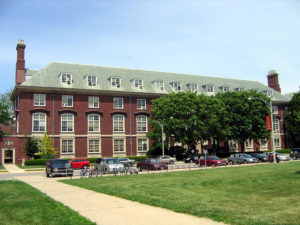Hillary Clinton to Offer Plan for Loan-Free Tuition at Public Colleges
With Americans owing a staggering $1.2 trillion in student loan debt, and about 8 million in default, her proposal reflects a Democratic push to reverse years of state cuts to higher ed. Creating a program of federal grants to the states to lower tuition is the centerpiece. Marc Nozell / CC BY 2.0
Marc Nozell / CC BY 2.0
Hillary Clinton on Monday will propose major new federal government spending to help undergrads pay tuition at public colleges without needing loans. With Americans owing a staggering $1.2 trillion in student loan debt, and about 8 million of them in default, the plan reflects a Democratic push to reverse years of state cuts to higher education.
Vox explains the proposed measures:
The problem Clinton wants to solve: states spend less per student than they used to
Democrats, including Elizabeth Warren, Bernie Sanders, and now Clinton, have called for the federal government to either force states to spend more on higher education, or to kick in additional federal funds to help states lower tuition or stop it from increasing. The goal is to ensure that students have the option of attending a public, in-state, four-year college with minimal debt — which was commonplace in the 1970s and 1980s but is increasingly rare now.
Clinton wants to ‘bend the cost curve’ in higher education
A goal of Clinton’s plan, according to a senior policy adviser in an interview Sunday, is to “bend the cost curve.” That means lowering the cost of actually providing the education, not just shifting who pays for it.
Creating a state grant program aimed at lowering tuition at public universities is the centerpiece of Clinton’s proposal. Clinton is calling for spending roughly $175 billion over 10 years on grants to states to lower tuition.
In order to qualify for the money, colleges would have to promise to set tuition rates so that students can afford them without taking out loans. It doesn’t promise that students will graduate debt-free — room and board and other living expenses often cost more than tuition at state universities.
Clinton wants to push colleges to increase graduation rates
Clinton’s plan also calls for colleges to improve their graduation rates — something the Obama administration has pushed colleges to do, so far without great success.
In 2009, Obama called for the US to again have the world’s highest proportion of young adults with a college degree by 2020. At the time, the US was ranked 12th. There have been small improvements — the nation is now tied for 11th — but there’s almost no chance the US will achieve the goal. (South Korea leads the world with a 67 percent college graduation rate, compared to 44 percent in the US.)
Clinton wouldn’t set a graduation rate cutoff for colleges to participate in the new grant to lower tuition program, but colleges would be required to demonstrate how they’re going to improve their graduation rates, the senior policy adviser said.
“We expect a commitment from colleges to do a better job,” the adviser said, and increasing completion rates is “a core component” of that.
Colleges would be held accountable in other ways. Clinton’s plan endorses risk-sharing — the idea that colleges should be liable for part of the costs to the federal government if students default on their loans — which has gotten bipartisan support in Congress.
Clinton would lower student loan interest rates — including for existing borrowers
Clinton is calling for setting the interest rate on student loans “so that the government never profits” — which the campaign said would cut the interest rate on student loans nearly in half. (Whether the government actually profits on student loans, and how much, is the subject of a fierce and partisan accounting battle, but the Congressional Budget Office has projected the federal government will make $127 billion over the next 10 years, mostly on graduate students.)
Clinton also wants people who have student loans to be able to refinance them, lowering their payments. Student loan interest rates are now tied to interest rates in the broader economy, and they’re currently low relative to where they were in previous years. A few private banks and finance companies let students refinance, but Clinton has proposed a more widespread effort to extend those lower interest rates to all borrowers.
Finally, Clinton is calling for a major change to how student loans are paid back: she wants all borrowers to repay their loans based on their discretionary income. Payments would vary as borrowers’ incomes change, and any remaining balance would be forgiven after 20 years of payments.
Clinton would continue many Obama higher ed policies
She would continue pushing for more transparency around student debt and post-graduation salaries at individual colleges to allow students to “shop around” — something Obama has emphasized. She would continue to enforce the gainful employment rule, which judges for-profit colleges and vocational programs based on their graduates’ debt and incomes after graduation. And her plans suggest that graduation rates would remain an important focus.
The idea that Clinton would continue Obama’s education policy isn’t as obvious as it might seem. The rest of the Democratic Party, including prominent voices on higher education such as Sen. Elizabeth Warren, haven’t been as enthusiastic on some of Obama’s ideas. Education Secretary Arne Duncan has said he’s concerned that the conversation about debt-free college, proposed most notably by Bernie Sanders, hasn’t focused enough on graduation rates.
Read more here.
–Posted by Roisin Davis
Your support matters…Independent journalism is under threat and overshadowed by heavily funded mainstream media.
You can help level the playing field. Become a member.
Your tax-deductible contribution keeps us digging beneath the headlines to give you thought-provoking, investigative reporting and analysis that unearths what's really happening- without compromise.
Give today to support our courageous, independent journalists.




You need to be a supporter to comment.
There are currently no responses to this article.
Be the first to respond.